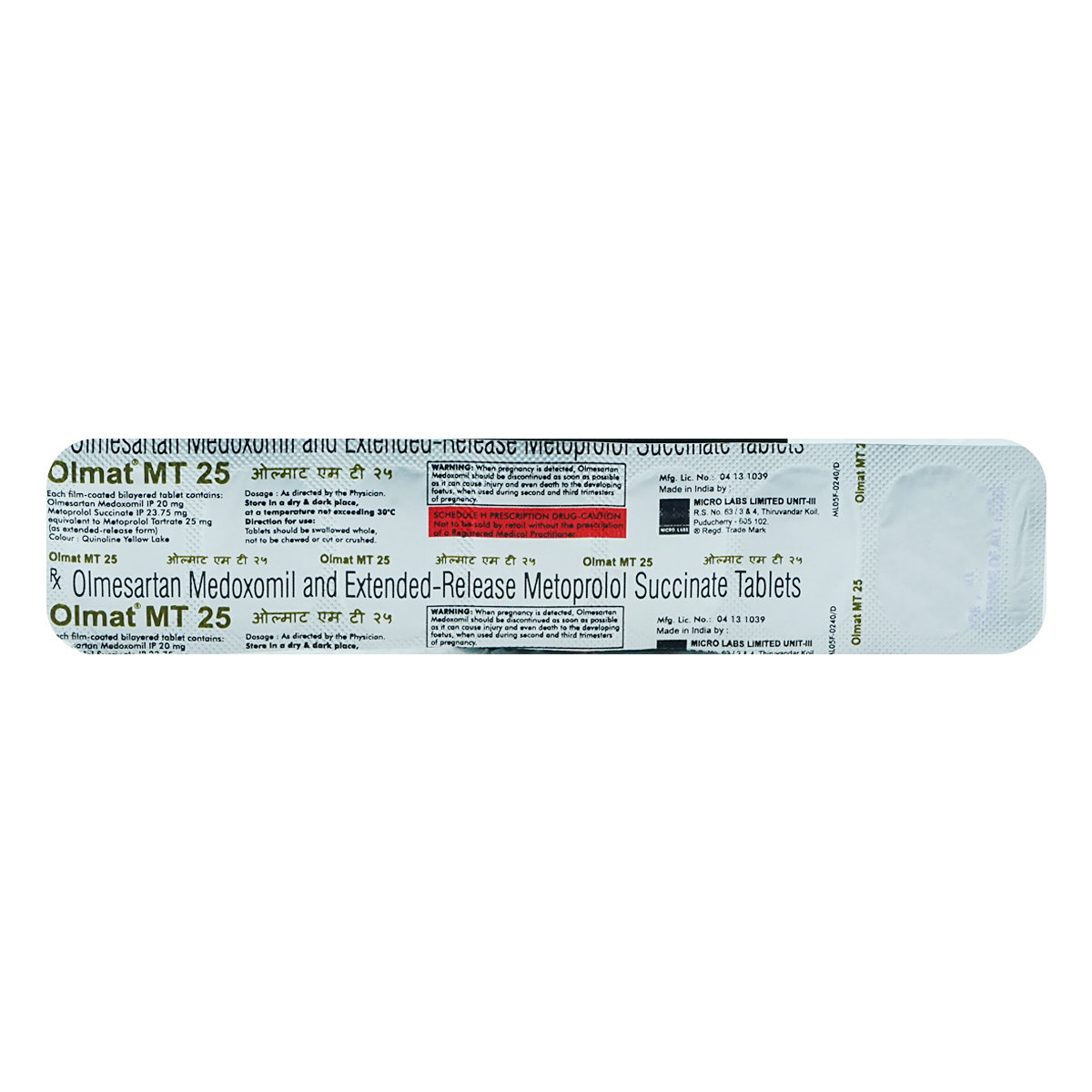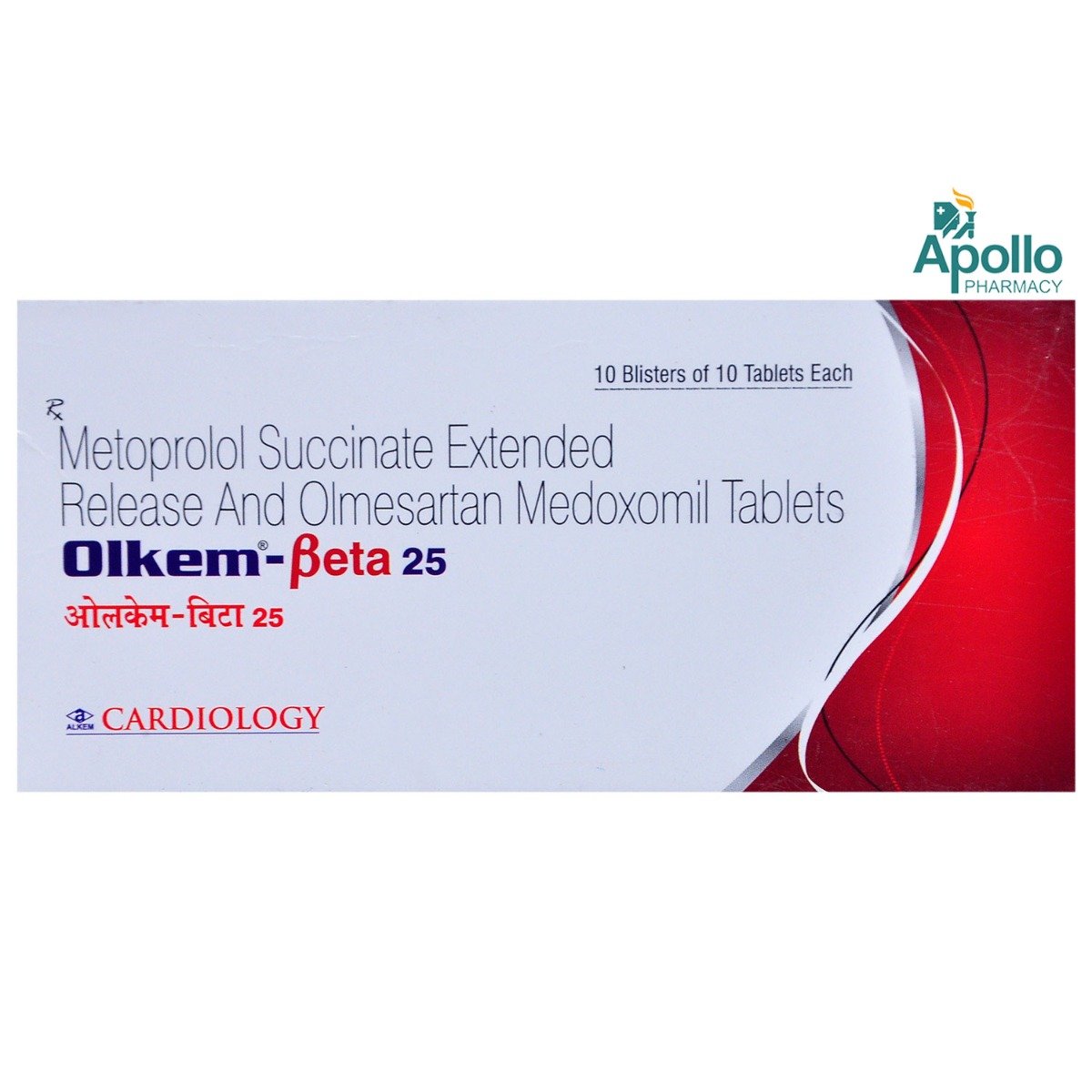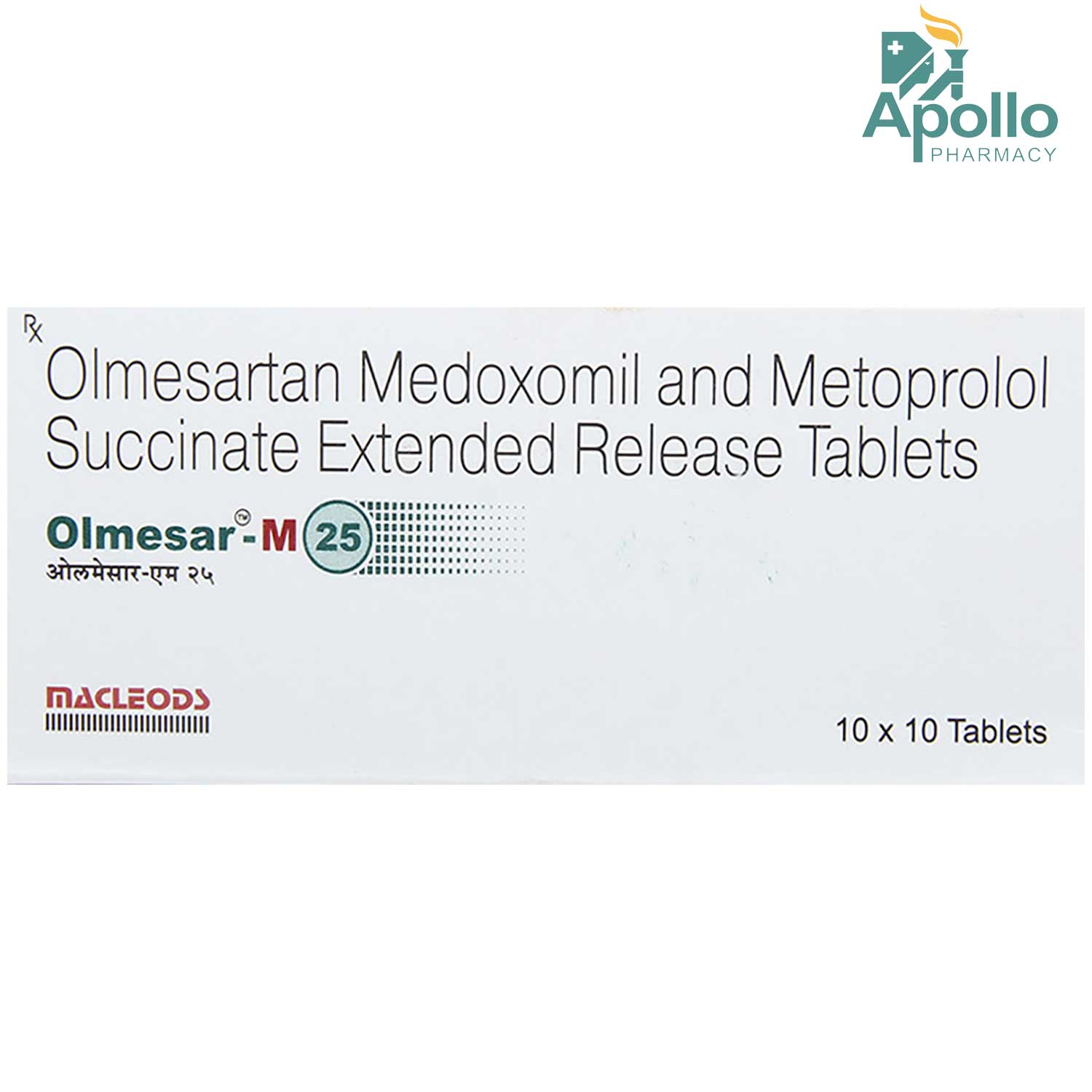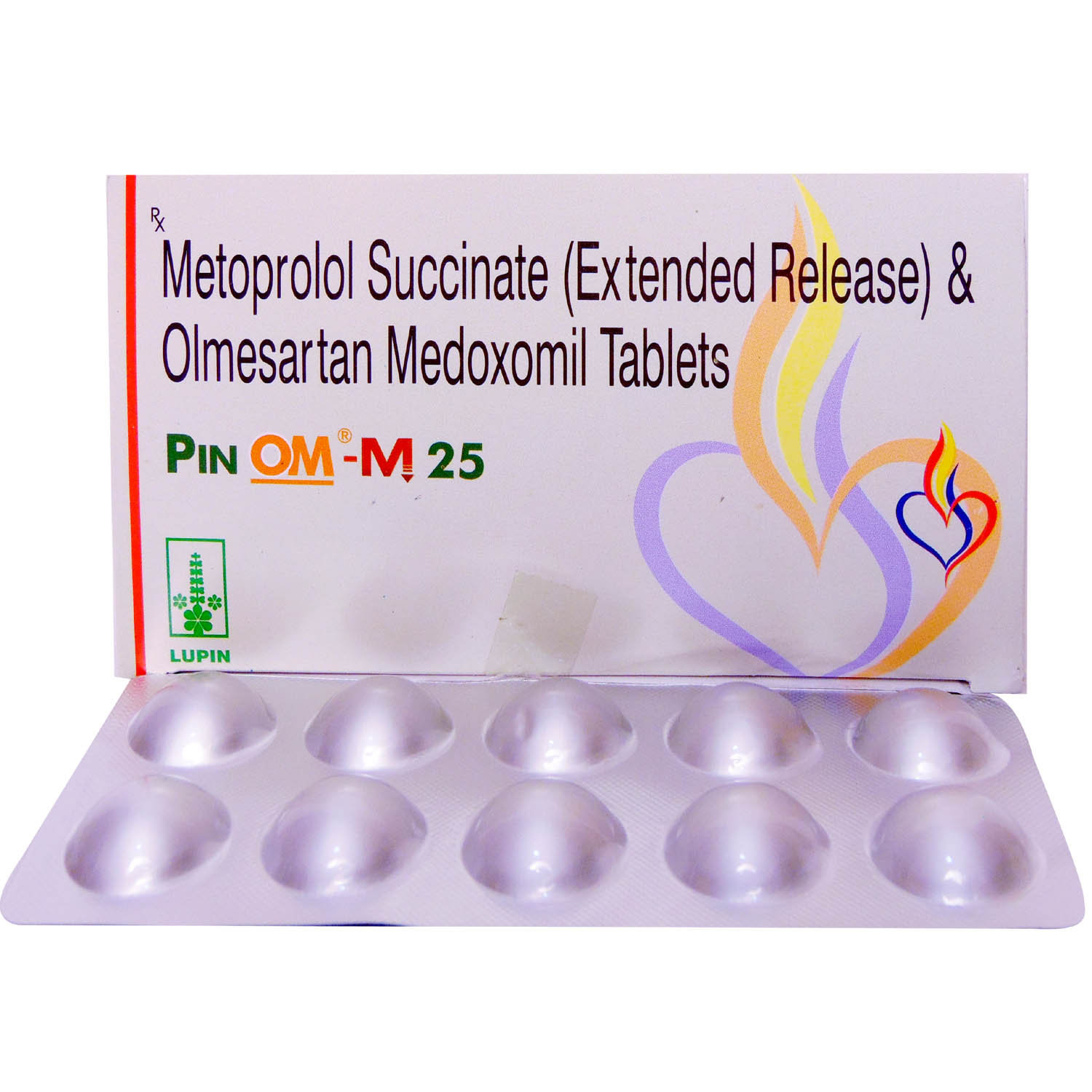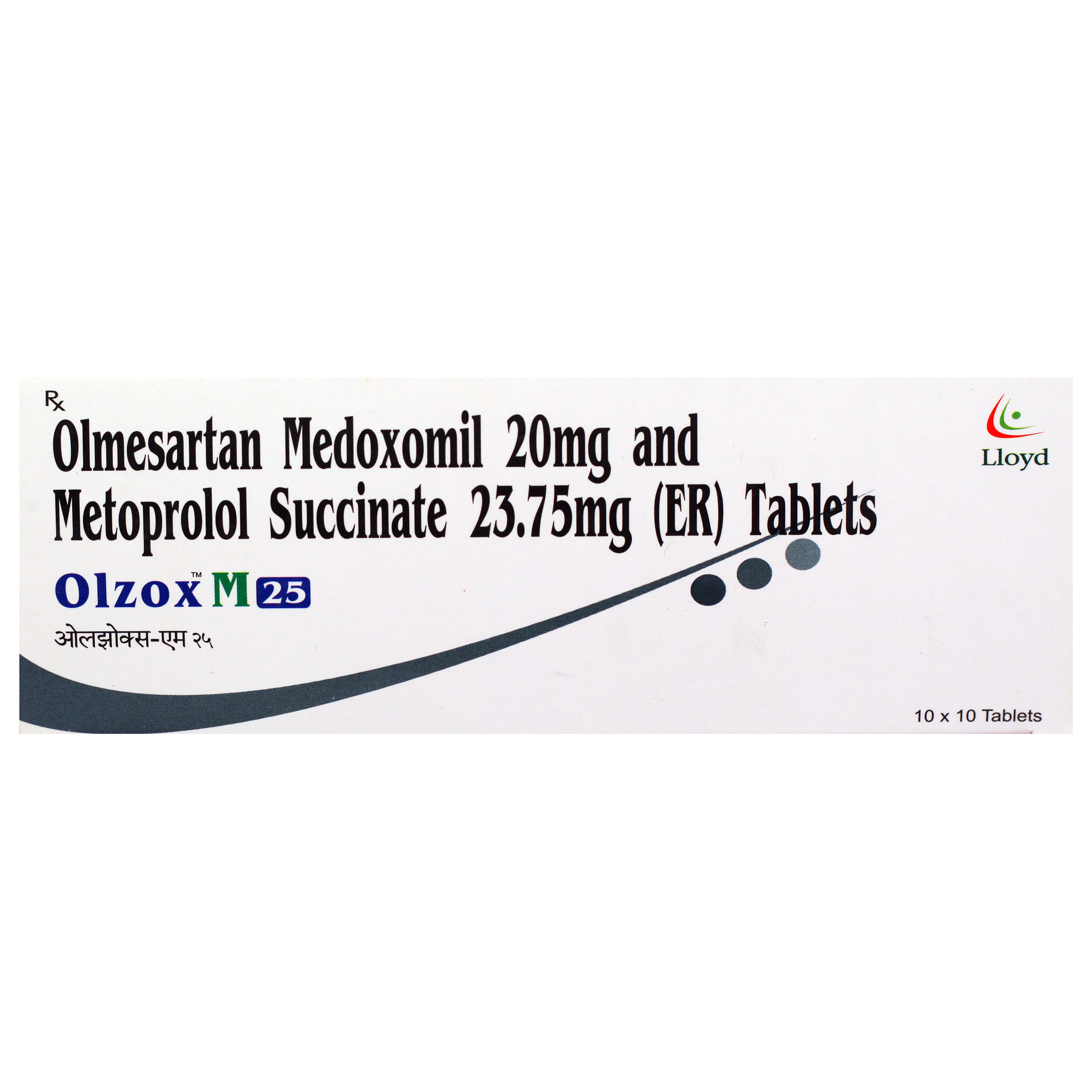Olsar-M 25 Tablet 10's
MRP ₹190
(Inclusive of all Taxes)
₹28.5 Cashback (15%)
Provide Delivery Location
Online payment accepted
 Prescription drug
Prescription drugWhats That
Composition :
Manufacturer/Marketer :
Consume Type :
Return Policy :
Expires on or after :
About Olsar-M 25 Tablet
Olsar-M 25 Tablet is a combination of blood pressure-lowering medicine, primarily used to treat high blood pressure. Olsar-M 25 Tablet contains Olmesartan (angiotensin receptor blocker) and Metoprolol (beta-blocker). Hypertension or high blood pressure is a chronic condition in which the force exerted by the blood against the artery wall is high. As a result, it leads to heart diseases, irregular heartbeat, and other complications.
Olsar-M 25 Tablet is a combination of two medicines, namely: Olmesartan and Metoprolol, which together helps in lowering raised blood pressure effectively. Olmesartan is an angiotensin receptor blocker (ARB). It works by blocking the hormone angiotensin, thereby relaxing blood vessels. This allows the blood to flow more smoothly and the heart to pump more efficiently. Metoprolol (beta-blocker) helps in relaxing our blood vessels by blocking the action of certain natural substances in your body. This lowers your blood pressure and helps in reducing your risk of having a stroke, a heart attack, other heart problems, or kidney problems in the future. This medicine needs to be taken regularly to be effective.
You can take Olsar-M 25 Tablet with food or without food. It should be swallowed whole with a glass of water. Do not chew, bite, or break it. Your doctor will advise you how often you take your tablets based on your medical condition. In some cases, you may experience headache, nausea, dizziness, increased potassium level, and low blood pressure. Most of these side effects of Olsar-M 25 Tablet do not require medical attention and gradually resolve over time. However, if the side effects are persistent, reach out to your doctor.
Try not to stop taking this medicine of your own. Let your doctor know about this, as it may cause a rise in blood pressure and can increase the risk of getting heart diseases and stroke. Inform your doctor if you are suffering from any kidney or liver or heart disease or are diabetic. If you are pregnant or breastfeeding, please tell your doctor so that the dosage of Olsar-M 25 Tablet can be prescribed accordingly. It should not be given to the children less than 12 years of age. Do not use Olsar-M 25 Tablet if you have low blood pressure (hypotension), cardiogenic shock (sudden stopping of blood flow to the heart). Please tell your doctor if you are taking any other medicines or are allergic to Olsar-M 25 Tablet . Reducing the amount of table salt (sodium chloride) in your food often relieves the swelling of the body. It would be best if you had regular potassium and electrolytes level check ups while taking Olsar-M 25 Tablet for preventing any complications.
Uses of Olsar-M 25 Tablet
Directions for Use
Medicinal Benefits
Olsar-M 25 Tablet is a combination of two medicines, namely: Olmesartan and Metoprolol, which together helps in lowering raised blood pressure effectively. Olmesartan is an angiotensin receptor blocker (ARB) which works by blocking the hormone angiotensin, thereby relaxing blood vessels. This allows the blood to flow more smoothly and the heart to pump more efficiently. Metoprolol (beta-blocker) helps in relaxing our blood vessels by blocking the action of certain natural substances in your body. This lowers your blood pressure and helps in reducing your risk of having a stroke, a heart attack, other heart problems, or kidney problems in the future. This medicine needs to be taken regularly to be effective.
Storage
- Exercising regularly helps lower the risk of heart problems.
- Maintain a healthy diet, including vegetables and fruits.
- Rest well; get enough sleep.
- Manage stress with yoga and meditation.
- Limit alcohol and smoking.
- If you experience symptoms like coughing, wheezing, chest tightness, or difficulty breathing after taking medication, seek medical attention immediately.
- Your healthcare provider will work with you to stop the medication causing the reaction, start alternative treatments, and provide supportive therapy.
- To manage symptoms and prevent complications, follow your doctor's advice to use inhalers or nebulizers as prescribed, practice good hygiene, avoid irritants, stay hydrated, and get plenty of rest.
- Regularly track your symptoms and report any changes or concerns to your healthcare provider.
- Talk to your doctor about your back pain and potential medication substitutes or dose changes.
- Try yoga or Pilates and other mild stretching exercises to increase flexibility and strengthen your back muscles.
- To lessen the tension on your back, sit and stand upright and maintain proper posture.
- To alleviate discomfort and minimize inflammation, apply heat or cold packs to the afflicted area.
- Under your doctor's supervision, think about taking over-the-counter painkillers like acetaminophen or ibuprofen.
- Make ergonomic adjustments to your workspace and daily activities to reduce strain on your back.
- To handle tension that could make back pain worse, try stress-reduction methods like deep breathing or meditation.
- Use pillows and a supportive mattress to keep your spine in the right posture as you sleep.
- Back discomfort can worsen by bending, twisting, and heavy lifting.
- Speak with a physical therapist to create a customized training regimen to increase back strength and flexibility.
- Limit fried foods and red meat.
- Increase your intake of whole foods such as vegetables, fruits, tree nuts and beans.
- Avoid air pollutants and unhealthy foods.
- Drink lots of water to detoxify your liver.
- Exercise regularly.
- Inform your doctor about the medication you're taking and the UTI symptoms you're experiencing.
- Your doctor may adjust your medication regimen or consider alternative medications or dosages that may reduce the risk of UTIs.
- Drink plenty of water (at least 8-10 glasses a day) to help flush out bacteria. Avoid sugary drinks and caffeine, which can exacerbate UTI symptoms.
- Urinate when you feel the need rather than holding it in. This can help prevent bacterial growth and reduce the risk of UTIs.
- Consider cranberry supplements: Cranberry supplements may help prevent UTIs by preventing bacterial adhesion.
- Monitor UTI symptoms and report any changes to your doctor.
- If antibiotics are prescribed, take them as directed and complete the full course.
- Inform your doctor about your anxiety symptoms so that you doctor may explore potential drug interactions and alter your treatment plan.
- Work with your doctor to adjust your medication regimen or dosage to minimize anxiety symptoms.
- Reduce anxiety symptoms by practicing relaxation techniques like meditation, deep breathing, or yoga.
- Regular self-care activities, such as exercise, healthy food, and adequate sleep, can assist control anxiety.
- Surround yourself with a supportive network of friends, family, or a support group to help manage anxiety and stay motivated.
- Regularly track anxiety symptoms and report any changes to your doctor to ensure your treatment plan is effective and adjusted as needed.
- Always wear loose-fitting clothes which are suitable for your activity.
- Include the diet containing fruits like watermelon, grapes, bananas and green leafy vegetables.
- Drink plenty of water stay hydrated.
- Avoid moving more and staying in hot sun.
Drug Warnings
Don't stop taking Olsar-M 25 Tablet without talking to your doctor first. Stopping Olsar-M 25 Tablet gradually may cause changes in your heart rhythm and blood pressure, cause chest pain, or a heart attack. Your doctor will lower your dose gradually over a period of time to help prevent these symptoms. You should not use Olsar-M 25 Tablet if you have a very slow heartbeat, asthma, serious heart condition (sick sinus syndrome), or any heart blockage. It should not be given to the children less than 12 years of age. Before taking Olsar-M 25 Tablet , you should tell the doctor if you have any muscle disorder (myasthenia gravis, rhabdomyolysis), breathing problem (COPD, bronchitis, emphysema), low blood sugar level (hypoglycaemia), low blood pressure (hypotension), depression, previous heart failure, liver/kidney disease, thyroid hormone disorder, adrenal gland cancer, or problems with circulation (Raynaud’s syndrome). Prolonged use of Olsar-M 25 Tablet may cause increased potassium level, so regular monitoring of serum potassium and electrolyte is essentially required.
Drug-Drug Interactions
Drug-Drug Interactions
Login/Sign Up
Using aliskiren together with olmesartan may increase the risk of serious side effects (kidney problems, low blood pressure, and high potassium levels in the blood).
How to manage the interaction:
Taking Olsar-M 25 Tablet with Aliskiren is not recommended as it can cause an interaction, they can be taken if advised by a doctor. You should seek medical attention if you experience nausea, vomiting, weakness, confusion, tingling of the hands and feet, feelings of heaviness in the legs, a weak pulse, or a slow or irregular heartbeat.It is crucial that you continue to consume enough fluids while taking these medications. Do not stop using any medications without consulting a doctor.
Using Olsar-M 25 Tablet with Potassium chloride may increase Potassium levels in the blood.
How to manage the interaction:
Although taking Olsar-M 25 Tablet together with Potassium chloride may lead to an interaction but can be taken if prescribed by the doctor. However, consult the doctor if you experience nausea, vomiting, weakness, disorientation, tingling in your hands and feet, feelings of heaviness in your legs, a weak pulse, or a slow or irregular heartbeat. It is important to maintain proper fluid intake while taking these medications. Do not stop using any medications without talking to a doctor.
Coadministration of Olsar-M 25 Tablet with potassium iodide may increase potassium levels in the blood. (High potassium levels can cause hyperkalemia, which can lead to kidney failure, muscular paralysis, abnormal heart rhythm, and cardiac arrest in extreme cases).
How to manage the interaction:
Although taking Olsar-M 25 Tablet together with potassium iodide may lead to an interaction but can be taken if prescribed by the doctor. However, consult the doctor if you experience nausea, vomiting, weakness, disorientation, tingling in your hands and feet, feelings of heaviness in your legs, a weak pulse, or a slow or irregular heartbeat. It is important to maintain proper fluid intake while taking these medications. Do not stop using any medications without talking to a doctor.
Taking Olsar-M 25 Tablet with trimethoprim may increase potassium levels in the blood.
How to manage the interaction:
Although taking Olsar-M 25 Tablet with trimethoprim may lead to an interaction but can be taken if prescribed by the doctor. However, consult the doctor if you experience nausea, vomiting, weakness, disorientation, tingling in your hands and feet, feelings of heaviness in your legs, a weak pulse, or a slow or irregular heartbeat. Do not stop using any medications without talking to a doctor.
Olsar-M 25 Tablet when combined with benazepril may cause low blood pressure, kidney problems, and may increase potassium levels in the blood.
How to manage the interaction:
Although taking Olsar-M 25 Tablet with benazepril may lead to an interaction but can be taken if prescribed by the doctor. However, consult the doctor if you experience nausea, vomiting, weakness, disorientation, tingling in your hands and feet, feelings of heaviness in your legs, a weak pulse, or a slow or irregular heartbeat. Do not stop using any medications without talking to a doctor.
Taking lithium with Olsar-M 25 Tablet may significantly increase the blood levels of lithium .
How to manage the interaction:
Although taking Olsar-M 25 Tablet alongside lithium can lead to interaction, they can be taken if prescribed by a doctor. However, if you develop sleepiness, dizziness, confusion, loose stools, vomiting, muscular weakness, muscle incoordination, a shaking sensation, blurred vision, ringing in the ears, excessive thirst, and/or increased urination, consult a doctor. Do not stop using any medications without talking to a doctor.
Taking Olsar-M 25 Tablet with triamterene may increase potassium levels in the blood. (High potassium levels can cause hyperkalemia, which can lead to kidney failure, muscular paralysis, abnormal heart rhythm, and cardiac arrest in extreme cases).
How to manage the interaction:
Although taking Olsar-M 25 Tablet with triamterene may lead to an interaction but can be taken if prescribed by the doctor. However, consult the doctor if you experience nausea, vomiting, weakness, disorientation, tingling in your hands and feet, feelings of heaviness in your legs, a weak pulse, or a slow or irregular heartbeat. Do not stop using any medications without talking to a doctor.
When Olsar-M 25 Tablet is taken with captopril, it may cause low blood pressure, kidney problems, and may increase potassium levels in the blood.
How to manage the interaction:
Although taking Olsar-M 25 Tablet with captopril may lead to an interaction but can be taken if prescribed by the doctor. However, consult the doctor if you experience nausea, vomiting, weakness, disorientation, tingling in your hands and feet, feelings of heaviness in your legs, a weak pulse, or a slow or irregular heartbeat. Do not stop using any medications without talking to a doctor.
Coadministration of Olsar-M 25 Tablet with fosinopril may cause low blood pressure, kidney problems, and may increase potassium levels in the blood.
How to manage the interaction:
Although taking Olsar-M 25 Tablet together with fosinopril may lead to an interaction but can be taken if prescribed by the doctor. However, consult the doctor if you experience nausea, vomiting, weakness, disorientation, tingling in your hands and feet, feelings of heaviness in your legs, a weak pulse, or a slow or irregular heartbeat. Do not stop using any medications without talking to a doctor.
Coadministration of Olsar-M 25 Tablet with perindopril may cause low blood pressure, kidney problems, and may increase potassium levels in the blood.
How to manage the interaction:
Although taking Olsar-M 25 Tablet together with perindopril may lead to an interaction but can be taken if prescribed by the doctor. However, consult the doctor if you experience nausea, vomiting, weakness, disorientation, tingling in your hands and feet, feelings of heaviness in your legs, a weak pulse, or a slow or irregular heartbeat. Do not stop using any medications without talking to a doctor.
Drug-Food Interactions
Drug-Food Interactions
Login/Sign Up
Lentils, Orange Juice, Oranges, Raisins, Potatoes, Salmon Dried, Spinach, Sweet Potatoes, Tomatoes, Coconut Water, Beans, Beetroot, Broccoli, Bananas, Apricots, Avocado, Yogurt
How to manage the interaction:
When Olsar-M 25 Tablet is taken along with potassium-containing salt substitutes or over-the-counter potassium supplements it may lead to high potassium levels in blood. Avoid taking potassium-containing salt substitutes or over-the-counter potassium supplements as this can lead to high potassium levels in blood. However, if you experience weakness, irregular heartbeat, confusion, tingling of the extremities, or feelings of heaviness in the legs, consult a doctor.
Diet & Lifestyle Advise
- Keep your weight under control with BMI (Body Mass Index) 19.5-24.9.
- Do regular physical activity or exercise for at least 150 minutes per week, or about 30 minutes most days of the week. Doing this can help you to lower your raised blood pressure by about 5 mm of Hg.
- Opt for a diet rich in whole grains, fruits, veggies, and low-fat dairy products.
- If you are taking alcohol then only one serving for women and two servings for men is advisable.
- Quitting smoking is the best strategy to lower the risk of heart disease.
- Avoid chronic stress as it can raise your blood pressure. Try to enjoy and spent time with your loved ones to cope with stress and practice mindfulness techniques.
- Monitor your blood pressure daily and if there is too much fluctuation then immediately contact your doctor.
- Try to include heart-healthy omega 3 fatty acids containing food drinks in your daily diet. You can also use low-fat cooking oil like olive oil, soybean oil, canola oil, and coconut oil can help in lowering your elevated blood pressure.
Side Effects of Olsar-M 25 Tablet
- Bradycardia (slow heart rate)
- Increased blood potassium level
- Cold extremities
- Gastrointestinal disturbances including nausea
- Fatigue
Habit Forming
Therapeutic Class
All Substitutes & Brand Comparisons
RX
Out of StockMet XL-O 25 Tablet 10's
Ajanta Pharma Ltd
₹85
(₹7.65 per unit)
55% CHEAPERRX
Olmat MT 25 Tablet 7's
Micro Labs Ltd
₹87
(₹11.19 per unit)
34% CHEAPERRX
Out of StockWINBP MT 25MG TABLET
Nicholas Piramal India Ltd
₹144.32
(₹12.99 per unit)
24% CHEAPER
Product Substitutes
Drug-Diseases Interactions
Drug-Diseases Interactions
Login/Sign Up
FAQs
It is advised to continue your medicine even after your blood pressure is under control or becomes normal as blood pressure can shot up any time. If you have any discomfort, please consult your doctor immediately.
Usually, Olsar-M 25 Tablet is prescribed for a long term treatment ranging from weeks to months for treating heart-related conditions and disorders. However, taking it on your own for years without a doctor's consent can be fatal. Hence, only take it as long as your doctor has prescribed it to you.
When you are taking a beta-blocker, your health care provider may recommend that you limit your consumption of bananas and other high potassium foods including papaya, tomato, avocado and kale.
Your doctor may probably tell you to stop taking Olsar-M 25 Tablet as it lowers blood pressure (hypotension) when combined with general anesthesia before surgery. So, please inform your doctor before surgery if you are taking Olsar-M 25 Tablet .
There is no clear cut clinical evidences that confirms Olsar-M 25 Tablet increase an individual's body weight. However it can affect your body use energy and make you tired. If you are worried about your weight gain you can speak to the doctor.
Yes, Olsar-M 25 Tablet can cause increased blood potassium level. It is recommended not to consume potassium rich diet or supplements while taking Olsar-M 25 Tablet to avoid increase in blood potassium level.
It's unlikely that Olsar-M 25 Tablet affects fertility in men or women. There's not enough evidence to say for certain. For best advise, consult your doctor.
Olsar-M 25 Tablet may cause dizziness, if you are lying down or sitting get up slowly to avoid it. If you feel extremely dizzy, please consult your doctor and do as advised.
Drug-Drug Interactions Checker List
- ACEBUTOLOL
- ATENOLOL
- BISOPROLOL
- CARTEOLOL
- ESMOLOL
- METOPROLOL
- NADOLOL
- NEBIVOLOL
- SOTALOL
- ALISKIREN
- AMILORIDE
- ENALAPRIL
- CAPTOPRIL
- QUINAPRIL
- THEOPHYLLINE
- IBUPROFEN
Special Advise
- Limit intake of sodium chloride (table salt) in your daily diet to 2300 mg per day or less than 1500 mg is ideal for most adults.
- Check your blood pressure regularly and make sure your blood pressure does go below than normal, consult your doctor when needed.
Disease/Condition Glossary
Hypertension: It is a chronic condition when blood pressure is too high. This condition can lead to hardened arteries (blood vessels), decreasing the blood and oxygen flow to the heart. Blood pressure is the measurement of the force that our heart uses to pump blood to all parts of the body. Raised blood pressure can cause chest pain (angina) and heart attack (when blood supply to the heart is blocked). Additionally, high blood pressure also causes brain damage (stroke) and kidney failure. High blood pressure can be diagnosed with the help of a blood pressure monitor or sphygmomanometer. Systolic pressure is the pressure when the heart pumps blood out. On the other hand, diastolic pressure is the pressure when your heart is at the resting stage between heartbeats. If your blood pressure is 140/90 mm of Hg, it means the systolic pressure is 140 mm of Hg and, diastolic pressure is 90 mm of Hg. Ideal blood pressure should be between 90/60 mm of Hg and 120/80 mm of Hg.
Health Queries

Have a query?
Alcohol
Unsafe
You are recommended not to consume alcohol along with Olsar-M 25 Tablet to avoid unpleasant side-effects.
Pregnancy
Unsafe
Olsar-M 25 Tablet should not be taken until prescribed. Olsar-M 25 Tablet is a Category B pregnancy drug which is considered unsafe for pregnant women. Olsar-M 25 Tablet can have some harmful effects on the baby (foetus), Your doctor will weigh the benefits and any potential risks before prescribing it to you. Please consult your doctor.
Breast Feeding
Safe if prescribed
Olsar-M 25 Tablet is usually not recommended in breastfeeding mothers. Limited human data available suggests that the drug does not do any significant harm to the baby. Consume only if benefits outweigh risks.
Driving
Unsafe
It is not recommended to drive after taking Olsar-M 25 Tablet as it may occasionally cause drowsiness or fatigue.
Liver
Caution
Olsar-M 25 Tablet to be taken with caution, especially if you have a history of liver diseases/conditions. The dose may have to be adjusted by your doctor.
Kidney
Caution
Olsar-M 25 Tablet to be taken with caution, especially if you have a history of kidney diseases/conditions. The dose may have to be adjusted by your doctor.
Children
Unsafe
Olsar-M 25 Tablet is not recommended in children. The safety and efficacy of Olsar-M 25 Tablet in children have not yet been established.



